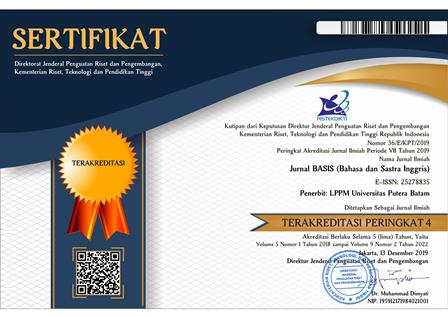REPRESENTATION OF JEALOUSY IN SHORT MOVIE “THE NEIGHBORS’ WINDOW”
DOI:
https://doi.org/10.33884/basisupb.v8i2.4438Keywords:
Academy Awards, Film, Oscars, Short Film, The Neighbors' WindowAbstract
Short films are often underestimated for their lack of duration. People think that the short duration will affect to how the messages are conveyed. However, short films are now very popular. There is even a category of best short film in Academy Awards, or well-known as Oscars. The Neighbors’ Window is one of many Oscars’ winners for best short film. This research aims to find out how jealousy is represented in the short film The Neighbors’ Window by Marshall Curry. This method of this research uses a theory from Saussure called semiotics. This research also uses an approach of Representation theory by Mary Beltran and Stuart Hall. Most of the data in this article is taken from scenes in the short film which later are connected with the theories. This result of this research shows that the important scenes presented in this movie are representation of Jealousy towards each character. This research shows that the movie is about jealousy presented by the symbols in the movie using some analytical research by applying the two theories.
References
Beltrán, M. (2018). Representation. In The craft of criticism (pp. 97–108). Routledge.
Bevan, J. L. (2008). Experiencing and communicating romantic jealousy: Questioning the investment model. Southern Communication Journal, 73(1), 42–67.
Bradbury, T. N., & Fincham, F. D. (1990). Attributions in marriage: Review and critique. Psychological Bulletin, 107(1), 3.
Curtin, B. (2009). Semiotics and visual representation. Semantic Scholar.
DiBello, A. M., Neighbors, C., Rodriguez, L. M., & Lindgren, K. (2014). Coping with jealousy: The association between maladaptive aspects of jealousy and drinking problems is mediated by drinking to cope. Addictive Behaviors, 39(1), 94–100.
Harmon-Jones, E., Peterson, C. K., & Harris, C. R. (2009). Jealousy: novel methods and neural correlates. Emotion, 9(1), 113.
Hart, S. L., & Legerstee, M. (2013). Handbook of jealousy: Theory, research, and multidisciplinary approaches. John Wiley & Sons.
Hupka, R. B., Zaleski, Z., Otto, J., Reidl, L., & Tarabrina, N. V. (1997). The colors of anger, envy, fear, and jealousy: A cross-cultural study. Journal of Cross-Cultural Psychology, 28(2), 156–171.
Martínez-León, N. C., Mathes, E., Avendaño, B. L., Peña, J. J., & Sierra, J. C. (2018). Psychometric study of the Interpersonal Jealousy Scale in Colombian samples. Revista Latinoamericana de Psicología, 50(1), 21–30.
Miller, M. J., Denes, A., Diaz, B., & Buck, R. (2014). Attachment style predicts jealous reactions to viewing touch between a romantic partner and close friend: Implications for internet social communication. Journal of Nonverbal Behavior, 38(4), 451–476.
Orvis, B., Kelley, H., & Butler, D. (1976). Attributional conflict in young couples. In JH Harvey, WJ Ickes, & RF Kidd (Eds.), New directions in attribution research, Vol. 1.
Petric, D. (2019). Envy vs. jealousy. https://doi.org/http://dx.doi.org/10.13140/RG.2.2.16576.17922
Sari, V. R. (2015). The Representation of Beauty Discourse by Media Text in Toni Morrison’s The Bluest Eye.
Stam, R., Burgoyne, R., & Flitterman-Lewis, S. (1992). New vocabularies in film semiotics : structuralism, post-structuralism, and beyond. Routledge.
Swami, V., Inamdar, S., Stieger, S., Nader, I. W., Pietschnig, J., Tran, U. S., & Voracek, M. (2012). A dark side of positive illusions? Associations between the love-is-blind bias and the experience of jealousy. Personality and Individual Differences, 53(6), 796–800.
Published
Issue
Section
License













 JURNAL BASIS (BAHASA DAN SASTRA INGGRIS)
JURNAL BASIS (BAHASA DAN SASTRA INGGRIS)
